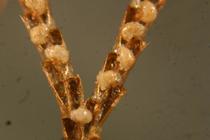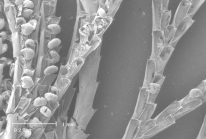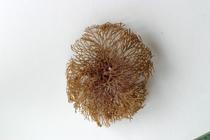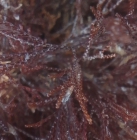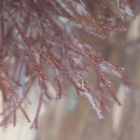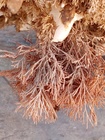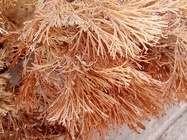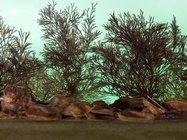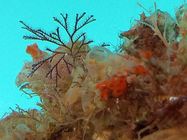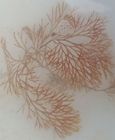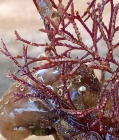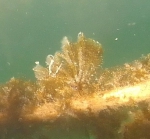WoRMS taxon details
Bugula neritina (Linnaeus, 1758)
111158 (urn:lsid:marinespecies.org:taxname:111158)
accepted
Species
Sertularia neritina Linnaeus, 1758 · unaccepted (basionym)
- Variety Bugula neritina var. minima Waters, 1909 accepted as Bugula minima Waters, 1909 (Basionym)
- Variety Bugula neritina var. ramosa Thornely, 1912 accepted as Bugula ramosa Thornely, 1912 (Basionym)
- Variety Bugula neritina var. rubra Thornely, 1912 accepted as Bugula robusta MacGillivray, 1869 (Subjective synonym)
- Variety Bugula neritina var. sessilis d'Hondt, 1974 accepted as Dendrobeania sessilis (d'Hondt, 1974) (Basionym)
- Variety Bugula neritina var. tenuata Thornely, 1912 accepted as Bugula robusta MacGillivray, 1869 (Subjective synonym)
- Variety Bugula neritina var. fastigiata Thornely, 1916 (uncertain > taxon inquirendum)
marine, brackish, fresh, terrestrial
(of Sertularia neritina Linnaeus, 1758) Linnaeus, C. (1758). Systema Naturae per regna tria naturae, secundum classes, ordines, genera, species, cum characteribus, differentiis, synonymis, locis. [The system of nature through the three kingdoms of nature, according to classes, orders, genera, species, with characters, differences, synonyms, places.]. <em>Impensis Direct. Laurentii Salvii. Holmiae [Stockholm].</em> 1(10) [iii], 824 p., available online at https://biodiversitylibrary.org/page/726886
page(s): 815 [details] Available for editors [request]
[request]
page(s): 815 [details] Available for editors
Bock, P. (2025). World List of Bryozoa. Bugula neritina (Linnaeus, 1758). Accessed through: World Register of Marine Species at: https://www.marinespecies.org/aphia.php?p=taxdetails&id=111158 on 2025-03-31
![]() The webpage text is licensed under a Creative Commons
Attribution 4.0 License
The webpage text is licensed under a Creative Commons
Attribution 4.0 License
Nomenclature
original description
(of Sertularia neritina Linnaeus, 1758) Linnaeus, C. (1758). Systema Naturae per regna tria naturae, secundum classes, ordines, genera, species, cum characteribus, differentiis, synonymis, locis. [The system of nature through the three kingdoms of nature, according to classes, orders, genera, species, with characters, differences, synonyms, places.]. <em>Impensis Direct. Laurentii Salvii. Holmiae [Stockholm].</em> 1(10) [iii], 824 p., available online at https://biodiversitylibrary.org/page/726886
page(s): 815 [details] Available for editors [request]
[request]
basis of record Hayward, P.J. (2001). Bryozoa, <B><I>in</I></B>: Costello, M.J. <i>et al.</i> (Ed.) (2001). <i>European register of marine species: a check-list of the marine species in Europe and a bibliography of guides to their identification. Collection Patrimoines Naturels,</i> 50: pp. 325-333 (look up in IMIS) [details]
page(s): 815 [details] Available for editors
basis of record Hayward, P.J. (2001). Bryozoa, <B><I>in</I></B>: Costello, M.J. <i>et al.</i> (Ed.) (2001). <i>European register of marine species: a check-list of the marine species in Europe and a bibliography of guides to their identification. Collection Patrimoines Naturels,</i> 50: pp. 325-333 (look up in IMIS) [details]
Other
context source (Introduced species)
Katsanevakis, S.; Bogucarskis, K.; Gatto, F.; Vandekerkhove, J.; Deriu, I.; Cardoso A.S. (2012). Building the European Alien Species Information Network (EASIN): a novel approach for the exploration of distributed alien species data. <em>BioInvasions Records.</em> 1: 235-245., available online at http://easin.jrc.ec.europa.eu [details] Available for editors  [request]
[request]
context source (Deepsea) Intergovernmental Oceanographic Commission (IOC) of UNESCO. The Ocean Biogeographic Information System (OBIS), available online at http://www.iobis.org/ [details]
context source (HKRMS) Lam KKY. (2001). Algal and sessile invertebrate recruitment onto an experimental PFA-concrete artificial reef in Hong Kong. In: Morton B, editor. Asian Marine Biology 17. Hong Kong University Press, Hong Kong. pp 55-76. [details]
context source (Bermuda) Sterrer, W. (1986). Marine fauna and flora of Bermuda: a systematic guide to the identification of marine organisms. <em>Wiley-Interscience Publication. Wiley.</em> 742 pp (Nemertini part). [details] Available for editors [request]
[request]
context source (PeRMS) Paredes, C.; Cardoso, F.; Tarazona, J. (1999). Invertebrados del intermareal rocoso del departamento de Lima, Perú: una lista comentada de especies. <em>Revista Peruana de Biología.</em> 6(2), 143-151. [details]
additional source Muller, Y. (2004). Faune et flore du littoral du Nord, du Pas-de-Calais et de la Belgique: inventaire. [Coastal fauna and flora of the Nord, Pas-de-Calais and Belgium: inventory]. <em>Commission Régionale de Biologie Région Nord Pas-de-Calais: France.</em> 307 pp., available online at http://www.vliz.be/imisdocs/publications/145561.pdf [details]
additional source Streftaris, N., A. Zenetos & E. Papathanassiou. (2005). Globalisation in marine ecosystems: the story of non-indigenous marine species across European seas. <em>Oceanogry and Marine Biology: an Annual Review.</em> 43: 419-453. (look up in IMIS) [details] Available for editors [request]
[request]
additional source Gordon, D. P.; Taylor, P. D.; Bigey, F. P. (2009). Phylum Bryozoa: moss animals, sea mats, lace corals. <em>in: Gordon, D.P. (Ed.) (2009). New Zealand inventory of biodiversity: 1. Kingdom Animalia: Radiata, Lophotrochozoa, Deuterostomia.</em> pp. 271-297. [details]
additional source Winston, J. E. and F. J. Maturo Jr. 2009. Bryozoans (Ectoprocta) of the Gulf of Mexico, Pp. 1147–1164 in Felder, D.L. and D.K. Camp (eds.), Gulf of Mexico–Origins, Waters, and Biota. Biodiversity. Texas A&M Press, College Station, Texas. [details]
additional source Liu, J.Y. [Ruiyu] (ed.). (2008). Checklist of marine biota of China seas. <em>China Science Press.</em> 1267 pp. (look up in IMIS) [details] Available for editors [request]
[request]
additional source Lutaenko, K.A.; Furota, T.; Nakayama; S.; Shin, K.; Xu, J. (2013). Atlas of Marine Invasive Species in the NOWPAP Region. Beijing: NOWPAP DINRAC (Northwest Pacific Action Plan, Data and Information Network Regional Center). 189 pp. [details]
additional source Hayward, P.J. & J.S. Ryland (Eds.). (1990). The marine fauna of the British Isles and North-West Europe: 1. Introduction and protozoans to arthropods. <em>Clarendon Press: Oxford, UK.</em> 627 pp. (look up in IMIS) [details] Available for editors [request]
[request]
biology source Tepolt, C. K. (2014). Adaptation in marine invasion: a genetic perspective. <em>Biological Invasions.</em> 17(3): 887-903., available online at https://doi.org/10.1007/s10530-014-0825-8
note: Here, I review evidence for adaptation in marine invasion, considering both quantitative and genetic studies. [details] Available for editors [request]
[request]
context source (Deepsea) Intergovernmental Oceanographic Commission (IOC) of UNESCO. The Ocean Biogeographic Information System (OBIS), available online at http://www.iobis.org/ [details]
context source (HKRMS) Lam KKY. (2001). Algal and sessile invertebrate recruitment onto an experimental PFA-concrete artificial reef in Hong Kong. In: Morton B, editor. Asian Marine Biology 17. Hong Kong University Press, Hong Kong. pp 55-76. [details]
context source (Bermuda) Sterrer, W. (1986). Marine fauna and flora of Bermuda: a systematic guide to the identification of marine organisms. <em>Wiley-Interscience Publication. Wiley.</em> 742 pp (Nemertini part). [details] Available for editors
context source (PeRMS) Paredes, C.; Cardoso, F.; Tarazona, J. (1999). Invertebrados del intermareal rocoso del departamento de Lima, Perú: una lista comentada de especies. <em>Revista Peruana de Biología.</em> 6(2), 143-151. [details]
additional source Muller, Y. (2004). Faune et flore du littoral du Nord, du Pas-de-Calais et de la Belgique: inventaire. [Coastal fauna and flora of the Nord, Pas-de-Calais and Belgium: inventory]. <em>Commission Régionale de Biologie Région Nord Pas-de-Calais: France.</em> 307 pp., available online at http://www.vliz.be/imisdocs/publications/145561.pdf [details]
additional source Streftaris, N., A. Zenetos & E. Papathanassiou. (2005). Globalisation in marine ecosystems: the story of non-indigenous marine species across European seas. <em>Oceanogry and Marine Biology: an Annual Review.</em> 43: 419-453. (look up in IMIS) [details] Available for editors
additional source Gordon, D. P.; Taylor, P. D.; Bigey, F. P. (2009). Phylum Bryozoa: moss animals, sea mats, lace corals. <em>in: Gordon, D.P. (Ed.) (2009). New Zealand inventory of biodiversity: 1. Kingdom Animalia: Radiata, Lophotrochozoa, Deuterostomia.</em> pp. 271-297. [details]
additional source Winston, J. E. and F. J. Maturo Jr. 2009. Bryozoans (Ectoprocta) of the Gulf of Mexico, Pp. 1147–1164 in Felder, D.L. and D.K. Camp (eds.), Gulf of Mexico–Origins, Waters, and Biota. Biodiversity. Texas A&M Press, College Station, Texas. [details]
additional source Liu, J.Y. [Ruiyu] (ed.). (2008). Checklist of marine biota of China seas. <em>China Science Press.</em> 1267 pp. (look up in IMIS) [details] Available for editors
additional source Lutaenko, K.A.; Furota, T.; Nakayama; S.; Shin, K.; Xu, J. (2013). Atlas of Marine Invasive Species in the NOWPAP Region. Beijing: NOWPAP DINRAC (Northwest Pacific Action Plan, Data and Information Network Regional Center). 189 pp. [details]
additional source Hayward, P.J. & J.S. Ryland (Eds.). (1990). The marine fauna of the British Isles and North-West Europe: 1. Introduction and protozoans to arthropods. <em>Clarendon Press: Oxford, UK.</em> 627 pp. (look up in IMIS) [details] Available for editors
biology source Tepolt, C. K. (2014). Adaptation in marine invasion: a genetic perspective. <em>Biological Invasions.</em> 17(3): 887-903., available online at https://doi.org/10.1007/s10530-014-0825-8
note: Here, I review evidence for adaptation in marine invasion, considering both quantitative and genetic studies. [details] Available for editors
 Present
Present  Present in aphia/obis/gbif/idigbio
Present in aphia/obis/gbif/idigbio  Inaccurate
Inaccurate  Introduced: alien
Introduced: alien  Containing type locality
Containing type locality
From regional or thematic species database
Introduced species impact in Australia (Nation) : Water abstraction or nuisance fouling [details]Introduced species impact in Australian part of the Coral Sea (Marine Region) : Other impact - undefined or uncertain [details]
Introduced species impact in Australian Exclusive Economic Zone (EEZ) : Water abstraction or nuisance fouling [details]
Introduced species impact in Chile (Nation) : Outcompetes native species for resources and/or space [details]
Introduced species impact Chinese part of the Eastern China Sea (Marine Region) Water abstraction or nuisance fouling [details]
Introduced species remark In Australian Exclusive Economic Zone (EEZ) : Bugula 'neritina' collected in Botany Bay, Australia, proved highly resistant as larvae and adults to dissolved copper, an active agent in many antifouling paints, and therefore have the potential to foul coated hulls (Piola and Johnston 2006). [details]
Introduced species remark In Chile (Nation) : Dumont et al. (2011) found that Bugula neritina dominated fouling communities in La Herradura Bay when predators (sea urchins, shrimp) were excluded by caging or by an unfavorable environment (sandy bottom). [details]
Introduced species vector dispersal in Australia (Nation) : Fisheries: accidental with deliberate translocations of fish or shellfish [details]
Introduced species vector dispersal in Australia (Nation) : Ships: general [details]
Introduced species vector dispersal in Australian part of the Coral Sea (Marine Region) : Ships: accidental as attached or free-living fouling organisms [details]
Introduced species vector dispersal in Australian part of the Coral Sea (Marine Region) : Ships: accidental with ballast water, sea water systems, live wells or other deck basins [details]
Introduced species vector dispersal United States part of the North Pacific Ocean (Marine Region) Aquaculture: accidental [details]
Introduced species vector dispersal Galapagos part of the South Pacific Ocean (Marine Region) Ships: accidental as attached or free-living fouling organisms
[details]
Introduced species vector dispersal Argentinean part of the South Atlantic Ocean (Marine Region) Ships: accidental as attached or free-living fouling organisms [details]
Introduced species vector dispersal Chinese part of the Eastern Chinese Sea(Marine Region) Ships: General [details]
Introduced species vector dispersal in United Kingdom (Nation) : Shipping [details]
| Language | Name | |
|---|---|---|
| Dutch | paars vogelkopmosdiertje | [details] |
| English | common bugulaBrown bryozoan | [details] |
| French | bugule brune | [details] |
| Japanese | フサコケムシ | [details] |
Marine Life Information Network - UK
To Barcode of Life (191 barcodes)
To Biodiversity Heritage Library (130 publications)
To Biodiversity Heritage Library (43 publications) (from synonym Sertularia neritina Linnaeus, 1758)
To Biological Information System for Marine Life (BISMaL)
To European Nucleotide Archive, ENA (Bugula neritina)
To GenBank (5920 nucleotides; 25976 proteins)
To Global Biotic Interactions (GloBI)
To Global Invasive Species Database (GISD)
To Information system on Aquatic Non-Indigenous and Cryptogenic Species (AquaNIS)
To PESI
To USNM Invertebrate Zoology Bryozoa Collection (76 records)
To Yale Peabody Museum of Natural History (YPM IZ 101969)
To ITIS
To Barcode of Life (191 barcodes)
To Biodiversity Heritage Library (130 publications)
To Biodiversity Heritage Library (43 publications) (from synonym Sertularia neritina Linnaeus, 1758)
To Biological Information System for Marine Life (BISMaL)
To European Nucleotide Archive, ENA (Bugula neritina)
To GenBank (5920 nucleotides; 25976 proteins)
To Global Biotic Interactions (GloBI)
To Global Invasive Species Database (GISD)
To Information system on Aquatic Non-Indigenous and Cryptogenic Species (AquaNIS)
To PESI
To USNM Invertebrate Zoology Bryozoa Collection (76 records)
To Yale Peabody Museum of Natural History (YPM IZ 101969)
To ITIS
